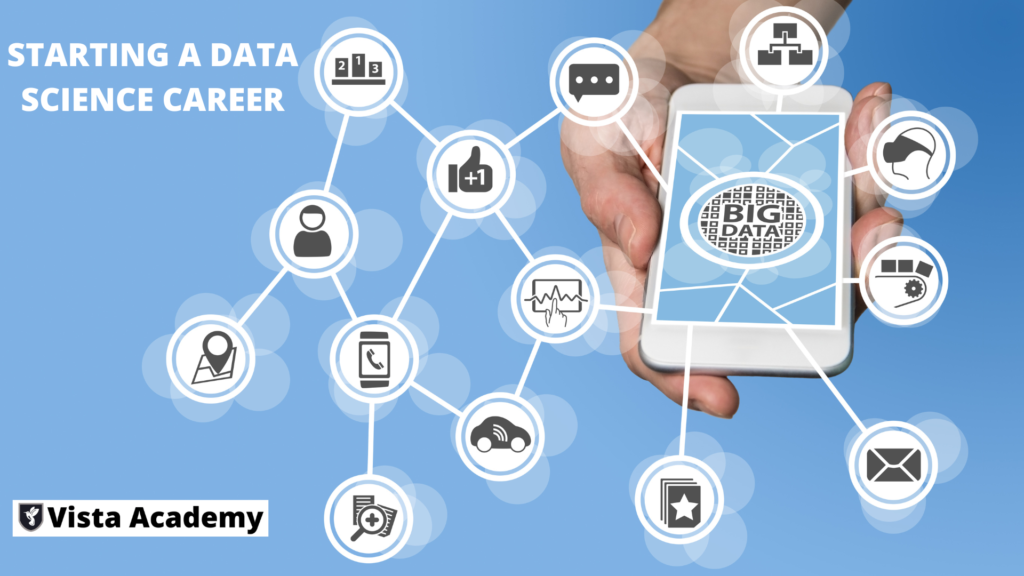Tips to Start your journey As Data Scientist from Scratch
Table of Contents
ToggleEssential Advice for People Starting a Data Science Career
It might be intimidating to learn data science. This is especially true when you are just getting started on your trip. Which tool should you learn first: R or Python? What tactics should you concentrate on? How many statistics do you need to know? Is it necessary for me to learn to code? These are just a few of the numerous questions you’ll have to answer along the way.
That is why I decided to write this tutorial to assist people who are new to analytics or data science. The goal was to produce a short, easy tutorial that will help you get started understanding data science. This tutorial will provide a foundation for learning data science during this challenging and daunting time.
It might be intimidating to learn data science. This procedure, in particular, does not need sophisticated mathematics, deep learning knowledge, or many of the other abilities listed above. However, it does need familiarity with a programming language as well as the ability to interact with data in that language. And, while mathematical fluency is required to excel at data science, a fundamental comprehension of mathematics is all that is required to get started.
The additional specific talents described above may assist you address data science difficulties in the future. To start a career in data science, you don’t need to master all of those talents. You may start right now, and I’m here to assist you!

Choose the appropriate role.
In the data science sector, there are many different positions to choose from. A data visualisation specialist, a machine learning expert, a data scientist, a data engineer, and other professions are just a handful of the numerous possibilities. Getting into one position may be simpler than another, depending on your history and previous experience. For example, if you’re a software developer, switching to data engineering shouldn’t be too tough. So, until and until you’re clear on what you want to be, you’ll be unsure of what path to pursue and what abilities to develop.
What should you do if you’re unsure about the distinctions or what you should become? The following are a few items I would recommend:
Find out what each of the positions requires by speaking with professionals in the business.
Take advantage of people’s mentoring by requesting a modest amount of time from them and asking pertinent questions. No one, I’m sure, would hesitate to assist someone in need!
Determine what you want and are excellent at, then select a career that fits your field of study.
Here’s a terrific resource to help you distinguish between business analyst, data scientist, and even data engineer —
Take on a Course and Finish It

Now that you’ve settled on a position, the next obvious step is to devote time and effort to learning the role. This entails more than simply going through the job’s needs. Because there is such a high need for data scientists, there are thousands of courses and studies available to help you learn whatever you desire. Finding information to learn from isn’t difficult, but learning it might be if you don’t put out the necessary effort.
When you enrol in a course, make an effort to complete it. Follow up with the curriculum, assignments, and all of the class conversations.
Now you have to diligently follow all the course material provided in the course. This also means the assignments in the course, which are as important as going through the videos. Only doing a course end to end will give you a clearer picture of the field.
Participate in a peer group.
Now that you’ve decided on whatever position you want to pursue and are preparing for it, the next step is to find a peer group to join. What is the significance of this? This is due to the fact that having a peer group keeps you motivated. Taking up a new field might be intimidating when you’re on your alone, but with friends at your side, the effort looks a little less frightening.
Having a group of individuals you can physically engage with is the best method to be in a peer group.
This is most likely the most often requested question by newcomers. The most easy option is to begin your data science adventure with any of the common tools/languages available.
This is most likely the most often requested question by newcomers. The most easy option is to begin your data science adventure with any of the common tools/languages available. After all, technologies are only instruments for putting ideas into action; comprehending the notion is far more crucial.
However, the issue remains as to which is the best alternative to begin with. At Vista Academy we will guide you to start a program in Data Science and step by step training
Concentrate on real-world applications rather than theory.
Concentrate on real-world applications rather than theory.
You should concentrate on the practical applications of what you’re learning when taking courses and training. This will assist you in not only comprehending the concept but also in gaining a better understanding of how it might be utilised in practise.
Following are a few pointers to keep in mind when taking a course:
- To fully comprehend the applications, make sure you complete all of the exercises and assignments.
- Apply what you’ve learned to a few open data sets. Comprehend the assumptions, what it accomplishes, and how to interpret the outcomes, even if you don’t understand the math behind a strategy at first.
- You may always go back and learn more at a later time.
- Take a peek at what people who have worked in the field have come up with.
- They’d be able to target you using the best method in a shorter amount of time.
Improve your communication abilities.
Improve your communication abilities.
In data science jobs, people don’t frequently equate communication abilities with rejection. They hope to ace the interview if they are technically proficient. This is a fabrication. Have you ever been turned down at an interview because the interviewer said thank you after hearing your introduction?
Once you’ve tried this task, have a buddy with strong communication skills listen to your introduction and give you honest comments. He’ll most certainly show you the mirror!
When working in the field, communication skills are even more crucial. You should be able to communicate effectively in order to discuss your thoughts with a colleague or to make your point in a meeting.
Learn python
The first and foremost step towards data science should be a programming language (ie Python). Python is the most common coding language, used by most data scientists, because of its simplicity, versatility, and being pre-equipped with powerful libraries (such as NumPy, SciPy, and Pandas) in data analysis and other aspects of data analysis. is useful. Science. Python is an open-source language and supports various libraries7
SQL and basic database expertise are required.
Tables don’t just emerge in the form of data. Beginners usually begin their machine learning adventure with data in the form of a CSV or excel file. But there’s something that’s lacking! It’s a SQL query. For a data science practitioner, it is the most essential ability.
Because firms are still sorting out their data science requirements, having knowledge of data storage strategies as well as the fundamentals of big data will make you far more appealing than someone with hi-fi terms on their CV.
These companies are looking for SQL experts that can assist them with day-to-day activities.
Data Visualization
Data visualization is the practice of translating information into a visual context, such as a map or graph, to make data easier for the human brain to understand and pull insights from. The main goal of data visualization is to make it easier to identify patterns, trends and outliers in large data sets.
Data visualization tools
- Tableau. Tableau is a data visualization tool that can be used to create interactive graphs, charts, and maps.
- QlikView.
- Microsoft Power BI.
- Datawrapper.
Machine Learning
For a profession in data science, predictive modelling employing machine learning techniques, tools, and algorithms is essential. Tree models, regression methods, clustering, classification strategies, and anomaly detection are all ideas you should be well-versed on. Without writing any Python code, you can work with datasets using a variety of services available online.
Making business judgments using data visualisation and its patterns is an excellent use of machine learning. To create charts, graphs, histograms, and other graphics used in client-side meetings, you can enlist the aid of Graphics User Interface (GUI) tools.
Staying on top of your resume game
Let’s try to figure out a riddle: What is the first thing a recruiter notices about you that might be your last? It’s your resume, after all! These are the final hurdles you must overcome in order to land the most sought job!
Make sure you incorporate these tips into your next resume —
Prioritize skills based on the employment role available.
To demonstrate your abilities, mention data science initiatives.
Remember to provide a link to your GitHub profile.
Certifications are less significant than skills.
Not once in a blue moon, but on a regular basis, update your talents and projects.
Make sure your typefaces and structure are consistent throughout your resume.

